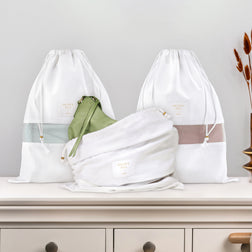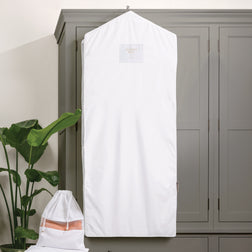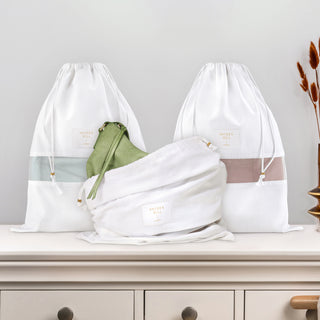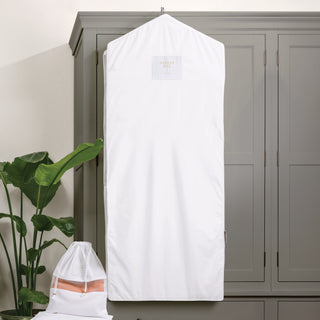If you follow these 12 seasonal clothing storage tips, your clothing will stay pristine while in storage. Remember to choose your storage bins and location wisely and to check on your items periodically. Once you are ready to use those garments again, they will be clean, fresh-smelling, and ready to wear.
For many around the country, another season is upon us. By storing your seasonal clothing, you can free up a lot of space in your closet and eliminate some clutter.
At least every six months, you should sort through your clothing, ideally in the spring and fall. Then you will be prepared when summer and winter temperatures arrive.
Top 12 Seasonal Clothing Storage Tips
Though putting away one season’s clothing and getting out a new one seems simple, there are certain steps you should take to keep all of your clothing in good condition and be certain the new season’s items are ready to wear.
1. Wash Your Clothes First
Prior to packing your seasonal belongings away, wash or dry clean everything. Stains can become permanent with time, and dirty clothing is a magnet for pests like moths.
Wash all of your clothing according to the instructions on the care tag, which will increase the lifespan of every garment you store.
2. Give Your Clothes Some TLC
After washing your items, examine every piece to see if anything needs to be repaired. Polish shoes, wipe down leather jackets, de-pill wool sweaters and coats, and sew on any missing buttons.

3. Donate Unworn Items
While selecting items to put in storage, it is the ideal time to sort through your clothing. If there are items you no longer wear or do not like, consider donating them. Helping someone in need while decluttering your closet is a win-win.
4. Find the Right Storage Containers
Once you are ready to store your seasonal clothing, the next step is to find the right storage containers.
Many people store their clothing in plastic containers. While plastic is great for short-term storage, like 3 to 6 months in a temperature-controlled unit, it is not ideal for long-term storage. Plastic can trap moisture, damaging the clothes inside.
The best storage containers are suitcases, acid-free garment bags, and cloth bins with zippers.
5. Know What to Fold and Hang
The type of fabric should dictate whether an item is hung or folded in storage. Delicate knits, sweaters, and blouses can lose their shape when hung for long periods. To prevent stretching, fold those pieces instead. Putting acid-free tissue paper inside delicate clothing can also help it to keep its shape.
If you hang some clothes, use wood or padded hangers only. The wider arms provide better support for the fabric and won’t leave any unseemly bumps or dents. Then place the hanged items inside garment bags to protect them from dust, dirt, and pests.
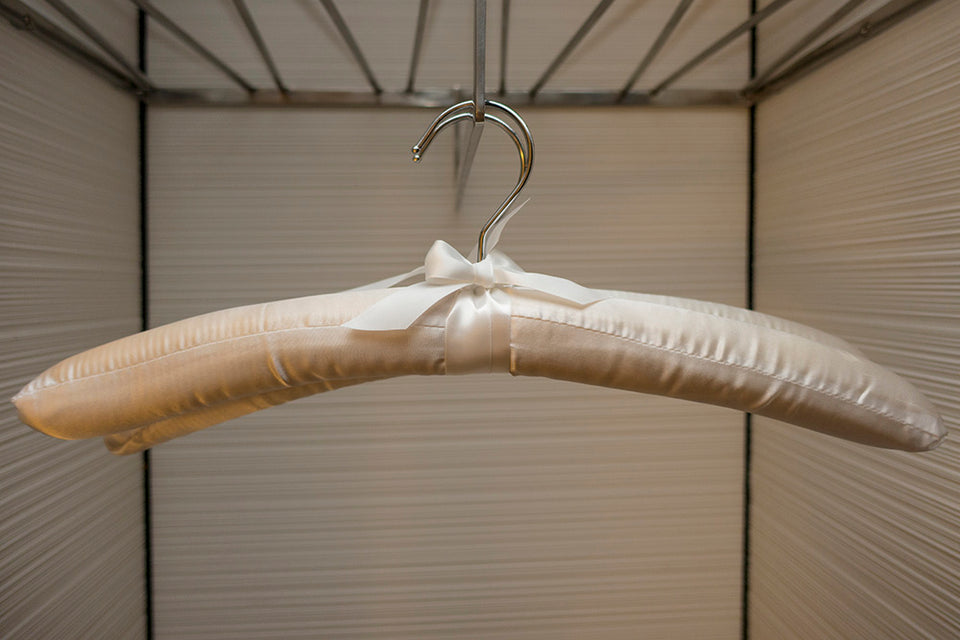
6. Store Your Clothes Somewhere Safe
A climate-controlled environment is best for your garments, especially when being stored long term. If such storage is unavailable to you or if you’re only storing your clothing short term, any place that is cool, dry, and indoors will work. Many people store their clothing in the basement or the attic, but these areas can be too hot or cold and humid.
You need a cool and dry location for two reasons. Sun exposure ruins clothing and fades colors. Dark and cool places prevent moisture build-up and keep insects at bay.
7. Use Cloth Garment Bags For Delicate Garments
Any specialty items you have, like evening wear, a wedding dress, or business attire, should be kept in a garment bag while in storage. Cloth garment bags are breathable and protect against moths and other critters.
Hayden Hill garment storage bags are ideal for long-term storage and are made of 100% organic, soft cotton with a sheer, organza side panel so you can see your pieces while keeping them protected.
Also avoid using dry cleaning bags or plastic bags for storage purposes. These bags are not breathable and can trap moisture on the inside. Mildew and yellowing can occur and damage your clothes.

8. Add Cedar Blocks or Chips
Traditionally, mothballs are often used when putting clothing in long-term storage. However, mothballs are rarely used correctly, and even when you properly seal them, the chemicals are still too dangerous to risk it. Instead, consider using cedar blocks, sachets, or chips.
Cedar not only smells great, but it is excellent for repelling insects and pests. You also don’t have to worry about any health concerns when using cedar. Just keep in mind that cedar should not come into direct contact with your clothing.
And if you don’t like cedar, lavender essential oil and dryer sheets are two other alternatives.
9. Label Everything
Knowing what is in each bin is useful when you have a large wardrobe. Label each garment bag or storage bin with a short description of what is inside.
You also consider numbering each bin and keeping a notebook or digital file detailing what is in each box. Choose whichever organizational method works best for you!
10. Not Everything Needs Vacuum-Sealing
Vacuum-sealing items to use less space sounds like a good idea, but there are some items that should never be compressed. When natural fibers are enclosed in a vacuum pack, it can damage the clothing. Some fibers take months to regain their natural form, while others never recover.
Remember, natural fibers, like wool, require air to breathe. When you vacuum-seal them away, you cut off any air circulation. Here are some items that should never be vacuum-sealed:
- Down jackets
- Towels
- Pillows
- Winter gloves
- Leather products
- Sleeping bags
- Comforters
- Cashmere and wool clothing
- Silk clothing
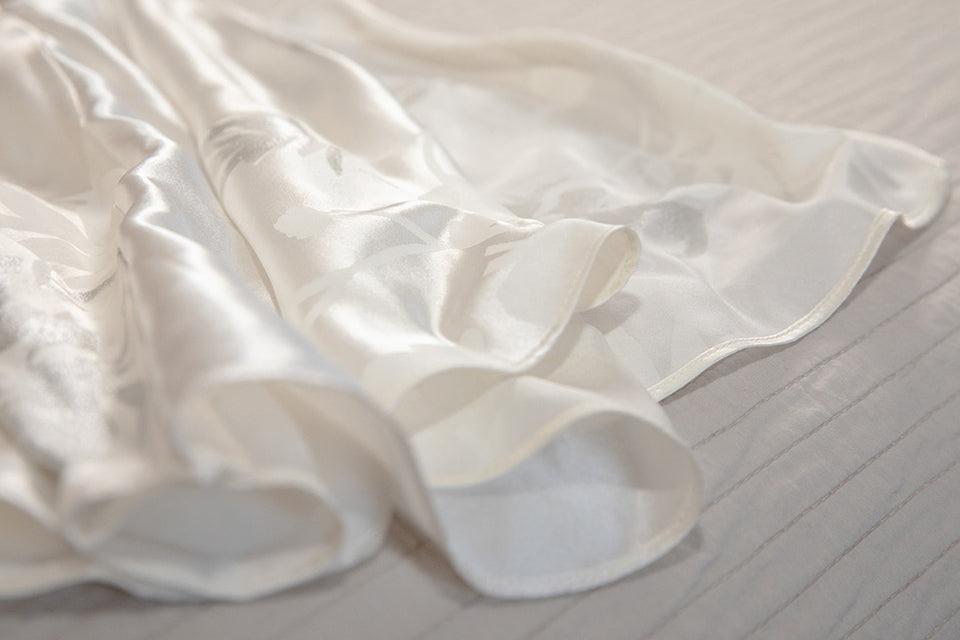
11. Avoid Over-Packing Bins
When too many garments are packed into a storage bin, there is a chance the lid or zipper won’t close correctly, which gives pests easy access to your clothing.
Plus, putting too many items into a bag or bin means a greater chance of wrinkling and damage to the fabric. To conserve space in your storage container, try rolling some of the items like t-shirts and pants. Not only does rolling save storage space, it also keeps items from wrinkling.
12. Check On Your Belongings Occasionally
If you plan on keeping some items in storage for an extended period of time, make sure you are ventilating the space occasionally and checking for damage.
When you are ready to remove your clothing from storage, carefully open the bins and take each item out for inspection. It is also good to rewash your clothes before wearing them. Check the boxes and bins, too. If there is any sign of cracking or yellowing, replace the bins before you store any other clothing.
FAQs
1. How do you store clothes between seasons?
When storing clothing between seasons, launder each item, fold it carefully, place it in the right container, and keep the container somewhere dark and cool. Avoid using plastic containers, as they can trap moisture and ruin your clothing.
2. How should I store my clothes for 6 months?
If you need to store clothing for 6 months, make sure the area is climate-controlled. Place your garments in a good storage bin, such as a zippered cloth bag, either folding or rolling each piece to prevent wrinkling. Garment bags can protect dresses, business suits, and other expensive items from damage while maintaining their structure. Check on your clothing occasionally and ventilate the space.
3. How do you store clothes for a long time?
First, find a place that is temperature-controlled or at least dark, cool, and not humid. Choosing the right environment goes a long way in storing clothing long term. Next, find the correct containers that will allow your clothing to breathe. Wash everything thoroughly before putting the items into the storage containers or cotton garment bags. Use cedar balls to protect your clothing from pests, and be sure to check on the stored items occasionally.
If you follow these 12 seasonal clothing storage tips, your clothing will stay pristine while in storage. Remember to choose your storage bins and location wisely and to check on your items periodically. Once you are ready to use those garments again, they will be clean, fresh-smelling, and ready to wear.
